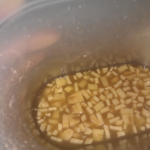 In this Junior Primary version of the ginger beer program,students make a batch of (non-alcoholic!) ginger beer over the course of 10 days and 3 workshop sessions.
In this Junior Primary version of the ginger beer program,students make a batch of (non-alcoholic!) ginger beer over the course of 10 days and 3 workshop sessions.
This is done in the classroom, and completely from scratch.
Ingredients
Plus some basic equipment.
Carbonating: The Old Way

In the process we let the mix catch naturally occurring yeast from the air – the way it used to be done… this means that the ginger beer mix starts producing very gentle carbon dioxide bubbles.
That’s right! CO2 is a natural by-product of the fermentation process, thus when properly brewed it does not need to be added.
Scope
During the various steps of the process, students explore areas of:
- Food science
- Biology (life cycles)
- Chemistry
- Maths (measurements, quantities, capacity)
Consumable Results
The students do all the work, look at (and listen to!) the results, and the final product can be consumed in a little classroom party.
The basic process yields approx. 4.5 L which is enough to provide a class of 25 students about 3/4 cup each.
The remaining ginger plant “gunk” can be used to start one or more new batches and do the process faster (since there is already yeast present from the start). It can be split and given to people to use at home, and it can be kept frozen.
Safety
Because we don’t add brewer’s yeast or any another “aggressive” ingredient, the fermentation process is very gentle. The mix does produce carbon dioxide but not at a huge rate, and we use plastic bottles so we can easily keep an eye on the expansion.
Pricing and Availability
This program can be facilitated by someone from OpenSTEM in conjunction with the class teacher, or run entirely by the teacher using the resources provided.
This program is also particularly suited for home schoolers and students learning through distance education, either individually or as a (remote) group project.
Contact us for more details!
For Senior Primary we have our more extensive Ginger Beer Café program (also non-alcoholic, of course).
Credits
This OpenSTEM program was developed by Arjen Lentz.
The ginger beer production process was adapted from a recipe documented by Rhonda Hetzel of Down to Earth.


History and Geography are no longer boring and dry, and the material provides a wide variety of topics.
Laura Davidson, Teacher